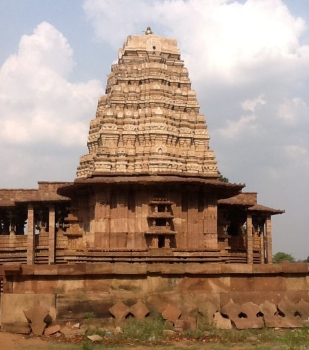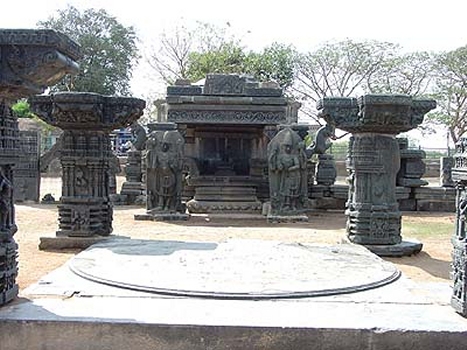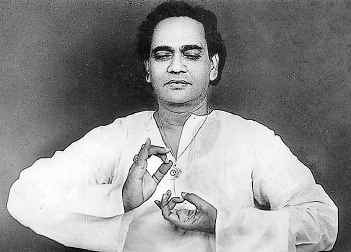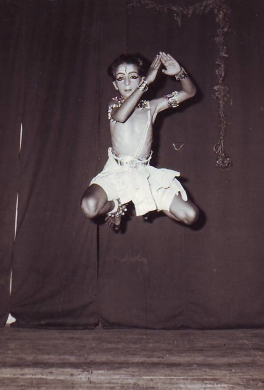
|
 |

|
 |
|
Perini Sivatandavam - Sudha Sridhar e-mail: sudhasridhar@hotmail.com February 19, 2017 (This article was first published in dance magazine 'Kalaspandan' from Bangalore) To understand one of the ancient Aradhana nrityas, Perini Sivatandavam, one needs to first go to or know about Ramappa Temple, the text Nritta Ratnavali by Jayapa Senani and Dr. Nataraja Ramakrishna, who revived the art in 20th century. Perini Sivatandavam is said to have been in practice / performed for over 1000 years and the peak of it can be traced to the golden period of Kakatiya dynasty (11th century) who are also credited to have brought Telugu speaking people under one aegis while laying emphasis on dance and culture. RAMAPPA TEMPLE  Palampet Ramappa temple  Balipeedam, Ramappa temple The Ramalingeswara temple situated in Palampet, which is at a distance of 77 kms from Warangal, is probably the only temple in India which is also named after its chief sculptor Ramappa. The temple has been described as the “brightest star in the galaxy of medieval temples in the Deccan.” The temple situated in a valley is built with bricks so light that they can float on water, yet they are strong and still intact even after the ravages of many invasions, wars and natural calamities. The Ramappa temple stands on a six feet cruciform plan. The sanctum is crowned with a shikara and is surrounded by a pradakshina patha, rich and intricate carvings adorn the walls, pillars and ceilings. The ceiling is divided into compartments by columns from the bottom and is carved with intricate patterns. Sculptures in the various pillars of the temple, depict the saptaswaras, dances like Sivapriya Nartanam, Madhanabala, Deryutham and Bhramana Nartanam as referred in Nritta Ratnavali text, the work of Jayapa Senani. There is a richness of carvings in this temple on dark rock with a smooth finish, portraying an amazing range of themes from the Puranas and various Indian mythological stories. The temple is one of the richest treasure trove for historians, architects, archeologists, dancers, musicians, alike. The sculptures depict the movements of the dance form followed then, the usage of instruments and its purports including the nuances of playing followed by observing the posture and the placement of the sculptors. Ramappa temple with its unique sculptors literally spoke to Dr. Nataraja Ramakrishna, when he ventured to understand them and thereby revived the long lost dance form Perni Sivatandavam. NRITTA RATNAVALI One of the Army Chiefs of the Kakatiya dynasty, Jayapa Senani, ventured to document the dance forms of his times and came out with two works, namely Nritta Ratnavali and Geetha Ratnavali. Unfortunately the latter work is not available while Nritta Ratnavali provides details about many dance methods which existed up to his time and it is regarded as one of the rare texts on dance. In the seventh chapter, he discusses in detail various aspects of Perini including the qualifications required for a Perini dancer, prescribed make up, ornaments that go with it. For instance, Jayappa Senani says that a Perini dancer should wear ornaments made of sea shells or gold. The dancer should apply ash all over the body and set his hair upright and tied and hold a dummy cobra or a wand in one hand and a ‘chamaram’ in the other hand. A much detailed study of his remarkable work throws more light on the dance form patronized during his time. It is remarkable that Jayapa Senani being a warrior, he was also very good when it came to art form, literature and used the pen to nicety as much as a warrior is expected to do with his sword. His work highlighting more sancharis (method) of usage of mridangam, jatis, gatis and chandoreetis are a sound treasure not only for the dancers but also an incredible work on music, poetry and Andhra dances, really a yeoman service done to the art world. DR. NATARAJA RAMAKRISHNA Dr. Nataraja Ramakrishna, a dance artist, guru, scholar and musicologist propagated classical dance in Andhra Pradesh for over six decades. His contributions to the art world are well appreciated and looked upon with reverence. His quest started in Srikalahasti when a temple renowned dancer encouraged him to observe closely the sculpture so that he can hear the language of the sculptors and feel the messages communicated by the silpams (sculptures). Thus, looking at the sculptures of the Ramappa temple and a detailed study of the Nritta Ratnavali text, Dr. Nataraja Ramakrishna was encouraged and inspired to revive the long forgotten Perini dance form once again. He went about documenting the same systematically for posterity apart from teaching the dance form to students simultaneously.  Nataraja Ramakrishna PERINI AS SEEN DURING THE KAKATIYA REGIME Perini Sivatandavam is believed to be one of the most invigorating and intoxicating dance forms - in the sense that being the dance of the warriors and performed in front of the idol of Lord Nataraja, as a mode of worship before leaving for the battlefield with the intention of invoking Lord Siva to dance through them, the dancers literally drove themselves to a state of spiritual awakening wherein they felt the power of Lord Siva at the physical level too. The warrior clans of the centuries particularly as documented in the 10th and 11th century performed in the temples as an invocation to Lord Siva. During the reigns of Ganapathi Rani Rudramma Devi, Pratapa Rudra Deva of Warangal, the worshippers of Lord Siva, the dance form as enacted is shown in detail in Jayapa Senani’s work. He describes as to how the dance form was practiced by the warriors / veera saivets (the sects of Veeras, Maheshulu, Pasupatis, Mylarudevulu) performing as ekapatra kelika to invoke the spirit of the Lord Siva inside them and seek his blessings for courage, strength and successful return to home from the battlefield. In temples, balipeetam had exit provisions on all the four sides and it was lit with oil lamps. It had enough room for the dancer to perform the kumba aarati watched by King Pratapa Rudra and queen Rudramma Devi. Those were the times when there were frequent invasion threats, the courage as depicted / instilled in Perini dance was part of their daily ritual. During their regime, even Saiva cult gained momentum. Perini was performed six times a day in a ritualistic manner dedicating the dance to Lord Siva as Sivaparana - to praise the lord during peace time or as Rudraparana – to encourage the warriors to wage war. PERINI SIVATANDAVAM DANCE FORM With the genesis of the rediscovery of the long lost unique dance form Perini Sivatandavam and its recorded glory during the Kakatiya regime briefly explained, let us see what is special and unique about Perini Sivatandavam. 
Perini Sivatandavam dance by Bhavani Shankar,
Broadly dance can be classified as lasya and tandavam. While lasya
stands for presenting emotions through soft body movements in a tender
way being delicate movements with lot of abhinaya, tandavam is seen more
as a forceful, majestic (veera) vigorous dancing, expressing the
combination of feelings and emotions. one of the direct disciples of Nataraja Ramakrishna Perini is a special art form belonging to natya melam tradition. As already expressed, historic evidence points out the fact that Perini was at its peak during the Kakatiyas’ time, primary reason may be since they spread more of Veera Saivam. Nritta Ratnavali text explains that Perini is a desi form of dance. The difference between showcasing Vishnu tatvam and Siva tatvam can be seen from the fact that Siva tatvam is bereft of any other form other than the Linga Akaram for worship, while Vishnu is worshipped in idols as per the nature or quality depicted. For example you can see Lord Vishnu worshipped as Anantasayana, etc. while Lord Siva is worshipped more as an abstract form (Linga) and the sadakas or devotees visualized that aspect of Siva that they wanted to imbibe through the worship of the Linga. In literature, both in Sanskrit and Telugu (Andhra literature), we find evidences for the existence of Perini dance form in the following works: 1. Palkuri Somana’s Panditha Raya Charitra.Except for Palkuri Somana’s book wherein the exclusivity of this dance form being a male domain is inferred, in all the other supporting literature it can be seen that even female dancers were performing Perini dance, especially the Raja Narthakis. Maybe Palkuri Somana being a Veera Saiva follower highlighted the dance form as a male bastion. With both the male and female dancers bearing reference in various texts one infers that Perini dance form is having both the lasya – tandava (compatible space for both). Generally kings are ascribed to show penchant for romance when it comes to dance and may be Perini at palace courts was more of lasya nartanam while at temples the veera saiva tandavam was performed, opines Nataraja Ramakrishna. He also observes that there are 5 repertoires Gargharam, Kavivaram, Bhavasyram, Vishamam and Geetham similar in Tanjore dance to Alarippu, Jatiswaram, Shabdam, Varnam and Abhinayam. Even Nandikesvara in his work Abhinaya Darpana has made a mention about Perini dance form. Typically, it starts with Gargharam and concludes with Siva Panchamukha Shabda Nartanam naturally in praise of Lord Siva. Gargharam means various fast movements of the anklets, primarily six parts, viz., Lakhadhimi, Siriberam, Halabedem, Patnam, Patavatam and Suripatem basically starting with sama pada posture. Specialty of Perini repertoire Vishamam, the dancer depicts Akashachari and Bhumicharis on sound (mridangam). Vishamam starts with Akashachari and ends with teermanam. Generally teermanams are three times while in Perini it is five times. Bhavasyram is a repertoire where usage of postures and hand gestures are expressed by way of a rhythmic dance. In Kavivaram, god is invitingly extolled while Geetham is all about depicting a song through dance particularly from the epics. Geetham starts in slow pace and then increases in speed. This music is of old tradition where veera rasa is played in ten kinds of Siva Leelas sung in Tripura Samharam, Gajasura Vadha, Manmadha Samharam, Parvati Parinayam, Ganga Avataranam. There are other repertoires in Perini like Bhramana Nartanam, in twenty five varieties of Bhramara such as Dhasina, Vama, Brujanga, Lath, Chatra, Kanda, etc. Yet another feature of Perini is Srunga Nartanam which depicts Lord Siva dancing for Parvati set in twilight backdrop. In Navarasa Angaharam Nartana, a very captivating dance, wherein navarasas are being expressed involving all parts of the body (anga, prathyanga and upanga). Special training needs to be imparted to bring out the veera, bhayanaka and rudra rasas through this extraordinary dance repertoire. In Perini repertoires, Pancha Mukha Sabdam Nartanam based on worship of the five elements Earth (Prithvi), Water (Jala), Fire (Thejo), Air (Vayu) and Sky (Akasha) has less of Hasthabinayam and more of akasha charis, bhramaris and karanas, it expresses the mood of the five elements in a very special manner and generally remains the last item of the dance performance. The orchestra primarily comprised of mukhaveena, mridangam, nadaswaram, talas and sruthi. The invocation music was called as ‘Melaveempu’ or ‘Melaprapthi’. In Perini, the role of mridangam is very special. The sound of mridangam produces vibrations in our body, with each beat having a start, induces and ebbs the vibration (Osthapathi, Parakasta and Anthardhana). The methodology of using mridangam in Perini is more akin to that of the usage in Drupada Sangeetham with a majestic felling of veera rasa unlike the usage seen as accompaniment to Carnatic music. While reinventing, Dr. Ramakrishna has given more importance to tradition followed rather than the text in totality. He has revitalized primarily the male aspect of Perini dance form as against the evidence seen in the texts, sculptors wherein both genders are portrayed to have performed Perini dance. Perini dance form has weathered many a cultural invasion and in the current form as documented through books and taught to a handful of interested aspirants needs to be preserved and propagated for generations to come. This is possible only by learning, practicing, showcasing the art form to a broader spectrum of audience both on national and international level. Sudha Sridhar, a double graduate in Law & Dance is a cultural activist working on advocacy efforts to preserve, promote and propagate art forms and for the cultural rights and welfare measures for artists. Currently her main focus is on Kuchipudi heritage village and promotion of all the three streams of South Indian Yakshagana - Karnataka Yakshaganam, Kuchipudi Yakshaganam and Melattur Bhagavathamela. Post your comments Please provide your name and email id when you use the Anonymous profile in the blog to post a comment. All appropriate comments posted with name & email id in the blog will also be featured in the site. |